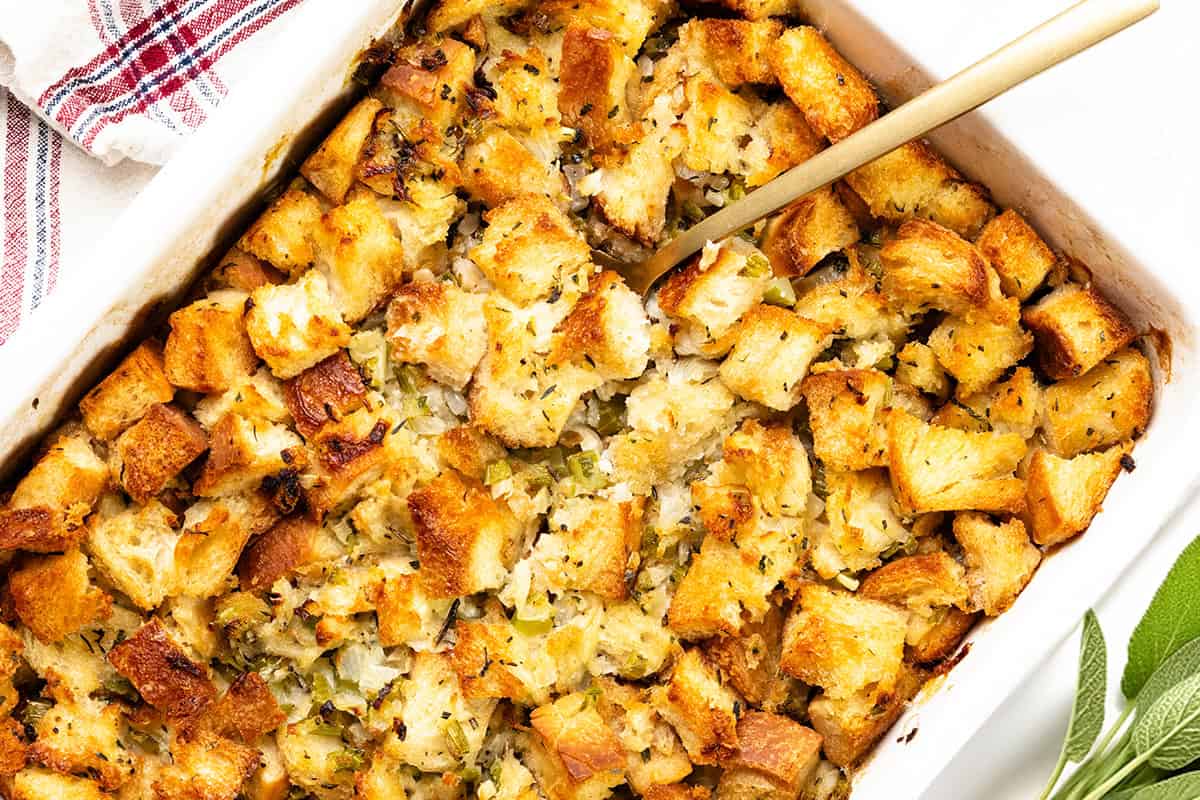
This site runs ads and generates income from affiliate links. Read my disclosure policy.
This delicious herb stuffing is full of flavor, with fresh herbs, sautéed vegetables, and perfectly toasted bread cubes. It’s easy to make ahead, leaving you more time to focus on your main dishes.
I love stuffing on Thanksgiving! There’s something about that warm, savory mix of herbs, buttery veggies, and golden toasted bread that just completes the holiday meal. Every bite brings a cozy, comforting flavor that pairs perfectly with turkey, gravy, and all the trimmings.
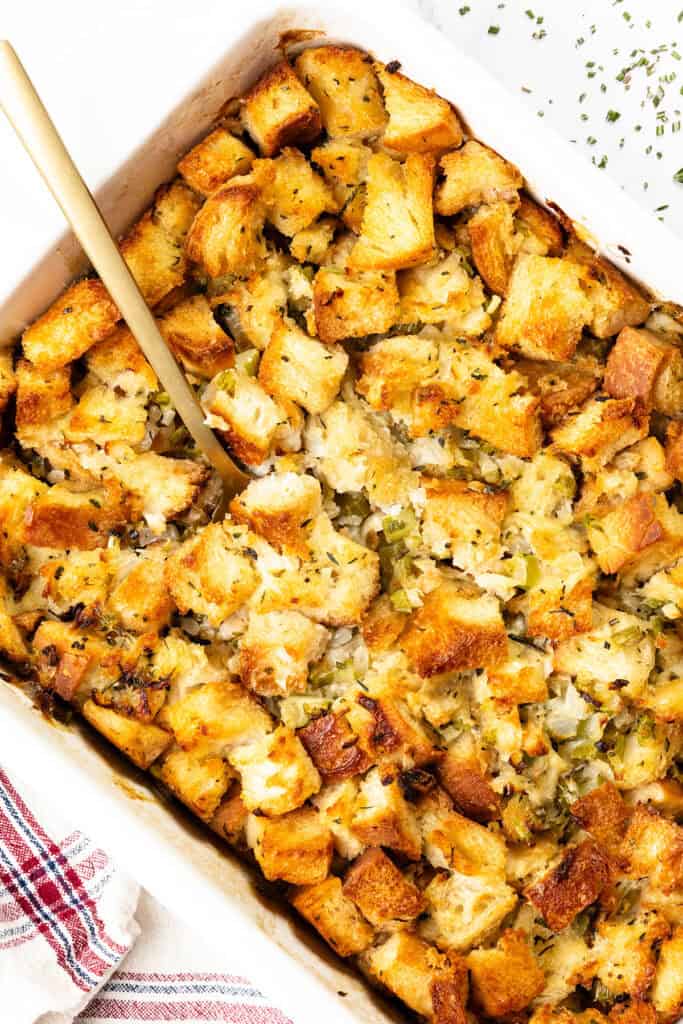
With a growing number of vegetarians in my family, this herb stuffing recipe has become a staple in my holiday lineup, not only because it’s easy to make but because it’s the kind of dish that feels like home. Whether you’re hosting a big family dinner or just want something extra special, this stuffing will bring warmth and flavor to your table.
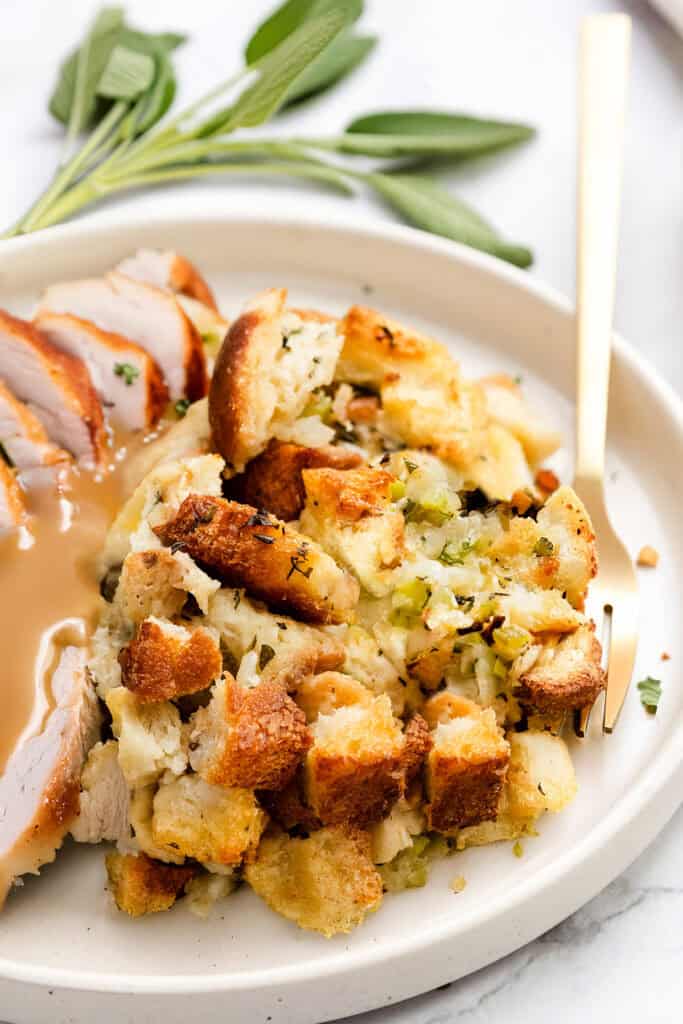
Why This Recipe Works
- Packed with Fresh Herbs: This stuffing bursts with the rich flavors of fresh sage, thyme, and rosemary, giving it a homemade taste you can’t beat.
- Perfectly Toasted Bread Cubes: The bread cubes are lightly toasted to create a perfect mix of crunchy and soft textures.
- Make-Ahead Friendly: Ideal for planning ahead, this stuffing can be prepped up to two days in advance.
What You’ll Need
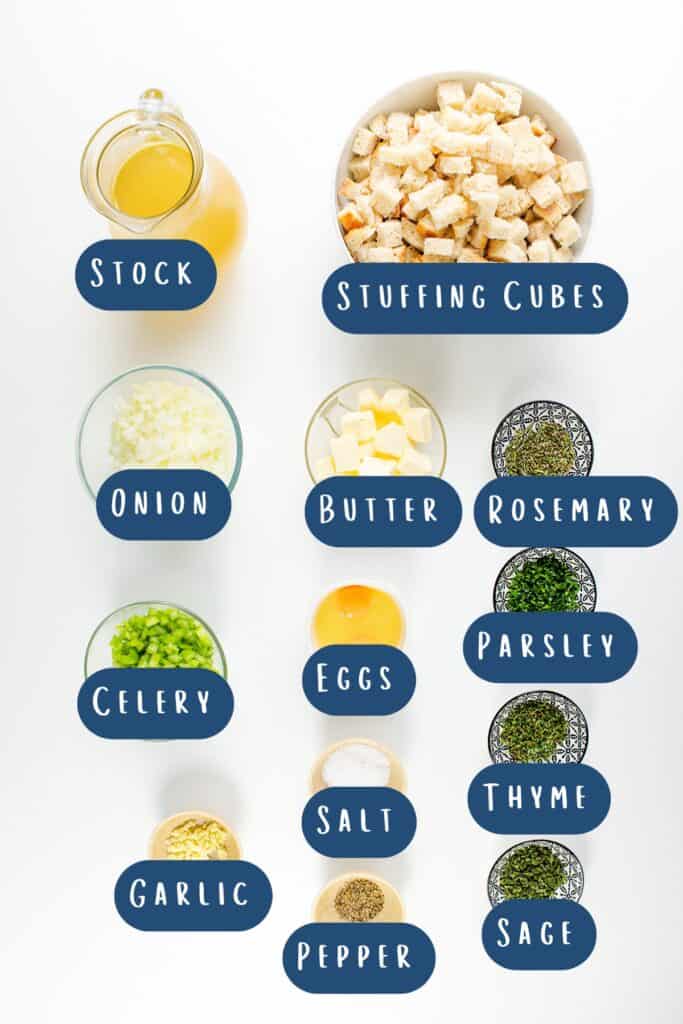
Rustic Bread
Best Choice: 1½ lbs of bread. Look for a crusty bread like sourdough or ciabatta for the best texture.
Substitutions: 24oz Package of stuffing cubes or dried cornbread stuffing mix.
Unsalted Butter
Best Choice: Unsalted butter helps you control the saltiness.
Substitutions: Salted butter can be used, but reduce the added salt in the recipe.
Eggs
Best Choice: Large eggs work best to bind everything together.
Substitutions: For a vegan version, try a flax egg (1 tablespoon ground flaxseed + 3 tablespoons water).
Onions and Celery
Best Choice: Fresh, medium-sized yellow onions and crisp, light-colored celery stalks are perfect for this recipe.
Substitutions: White onions work if you prefer a milder flavor.
Herbs (Sage, Thyme, Rosemary, Parsley)
Best Choice: Fresh herbs give the best flavor, but dried herbs are a good backup.
Substitutions: Use 2 teaspoons of dried herbs for each tablespoon of fresh, except parsley. I think dried parsley lacks flavor, so I would just omit it.
Stock
Best Choice: Homemade Chicken stock (or turkey stock) will always bring the best flavor, but low-sodium chicken broth can be used for a savory but balanced flavor.
Substitutions: Vegetable broth works well if making a vegetarian version.
Where to Find: Soup aisle or near packaged soups.
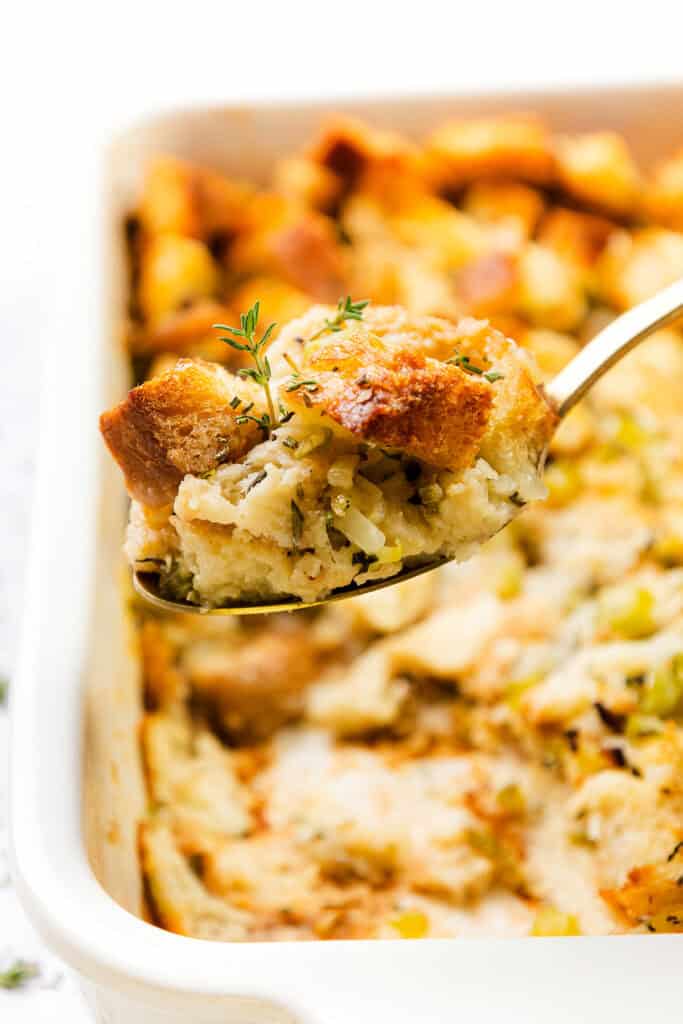
Bread & Stuffing Options
Pre-made Stuffing Cubes: Using fresh bread is not required. You’re welcome to use store-bought for this recipe. A 24oz bag will work as written, but an 18oz bag will require 2½ cups of chicken stock instead of 3 cups.
For Cornbread Stuffing, simply substitute equal parts of store bought cornbread cubes or dressing mix. To use fresh cornbread, toast the cornbread cubes until dried, as they tend to be softer than traditional bread and can easily become mushy.
If you live outside the US and only have stuffing breadcrumbs available, and you don’t want to cube your bread, you would need about 8 to 10 ounces (225 to 280 grams) of dried stuffing breadcrumbs. This is roughly half the volume of cubed bread because breadcrumbs are denser and will absorb liquid more quickly.
Step By Step Instructions
You can find the full, printable recipe at the bottom of this post (click the button above), but you can read a summary with step-by-step instructions and photos for each step below.
Equipment Recommendations: A 9×13-inch baking dish and a large mixing bowl are essential. A sharp knife for chopping and a large skillet for sautéing make preparation easier.
Preheat and Toast Bread: Preheat oven to 350°F (175°C). Spread the bread cubes evenly on two large baking sheets. Toast for 20-25 minutes, stirring occasionally until they’re dry and lightly golden. Set aside to cool.
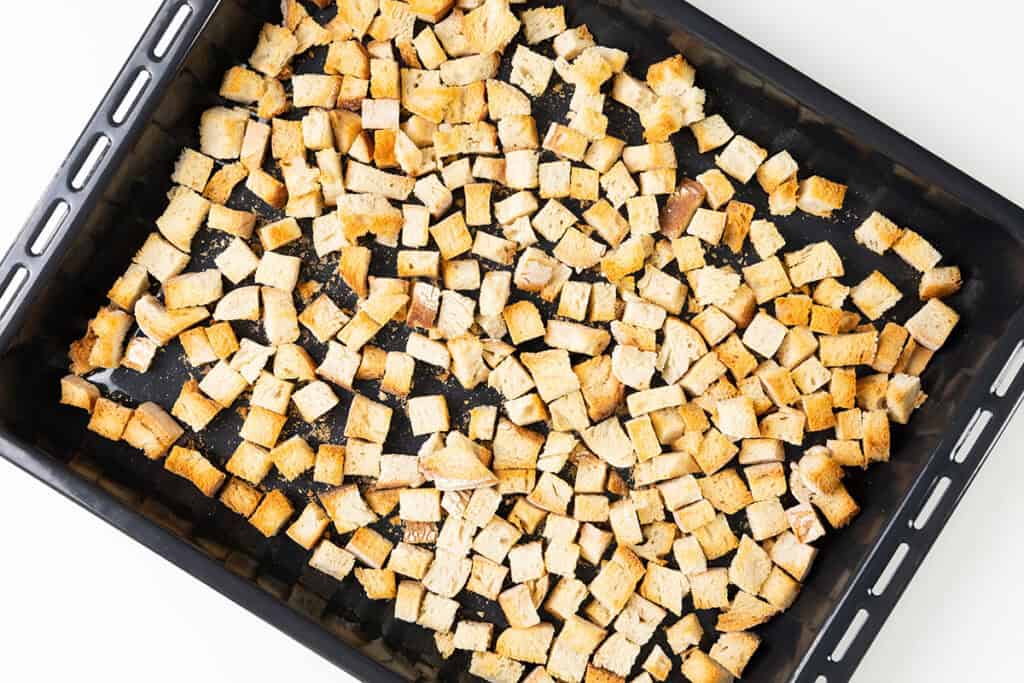
Sauté Vegetables: In a large skillet, melt 14 Tablespoons of butter over medium heat. Add the onions (2 large, finely chopped) and celery (6 stalks, finely chopped) and cook for 8-10 minutes, until softened and translucent. Add 4 minced garlic cloves and the fresh herbs (thyme, sage, rosemary, and parsley), and sauté for an additional 2-3 minutes until fragrant. Remove from heat.
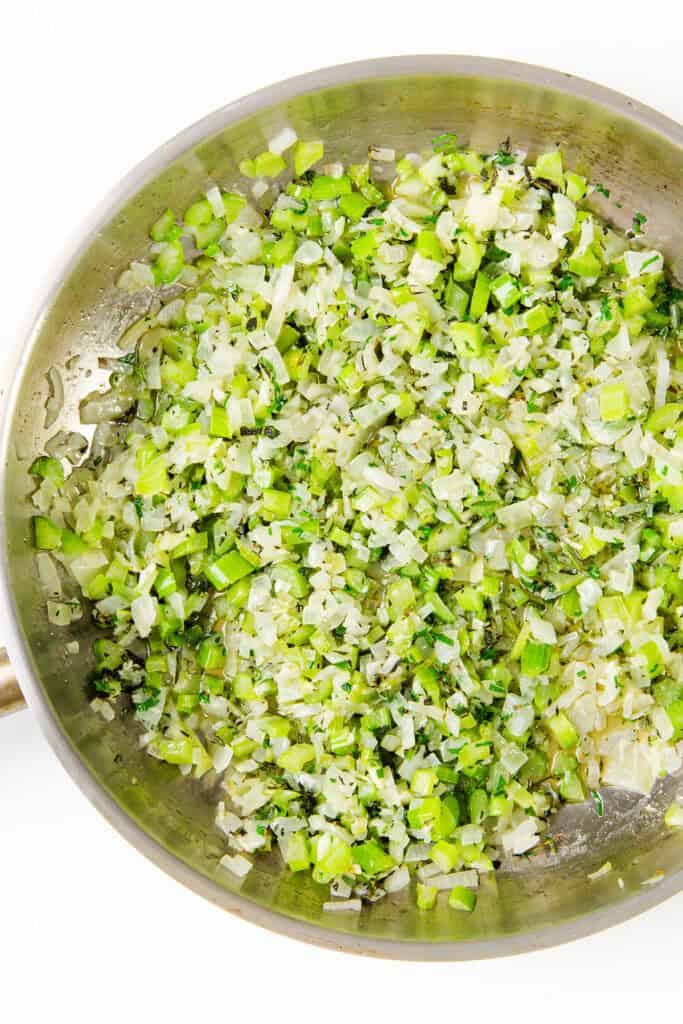
Combine Ingredients: In a large mixing bowl, combine the toasted bread cubes and sautéed vegetable mixture. Gradually pour in 2½ cups of chicken or vegetable broth, stirring to moisten the bread evenly. Once absorbed, if it looks dry, add the rest of the stock until it reaches your desired consistency. Season with salt and pepper to taste.
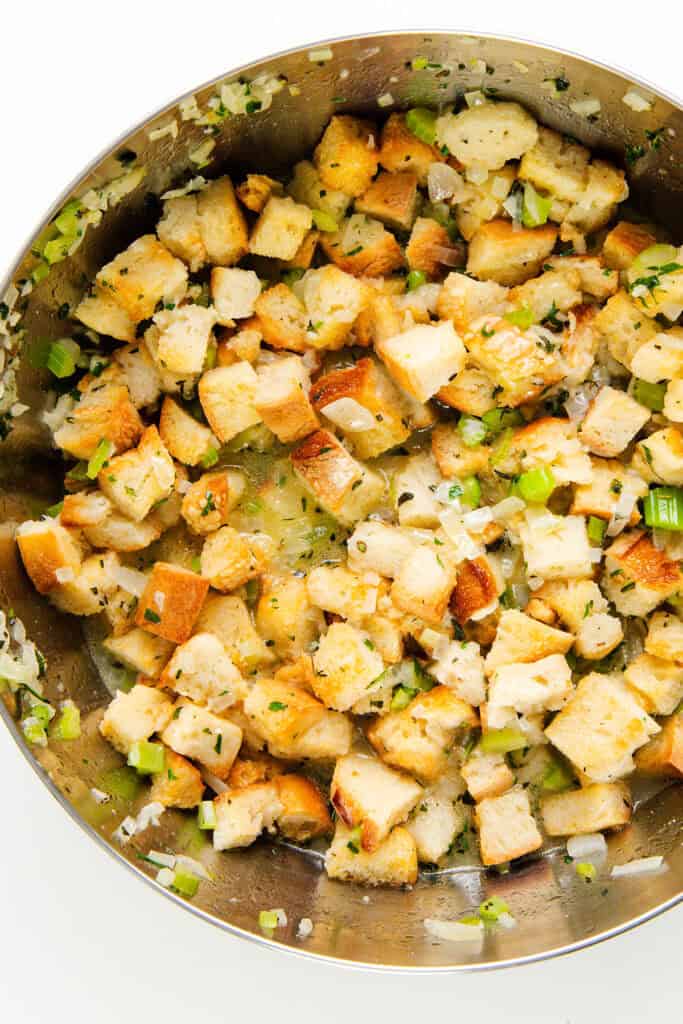
Add Eggs and Mix: In a small bowl, whisk 2 large eggs and add them to the bread mixture, stirring until everything is well combined.
Assemble and Chill: Transfer the mixture to a greased 9×13-inch baking dish, pressing down gently to level the top. Cover with plastic wrap and foil. Refrigerate for up to 2 days if prepping ahead.
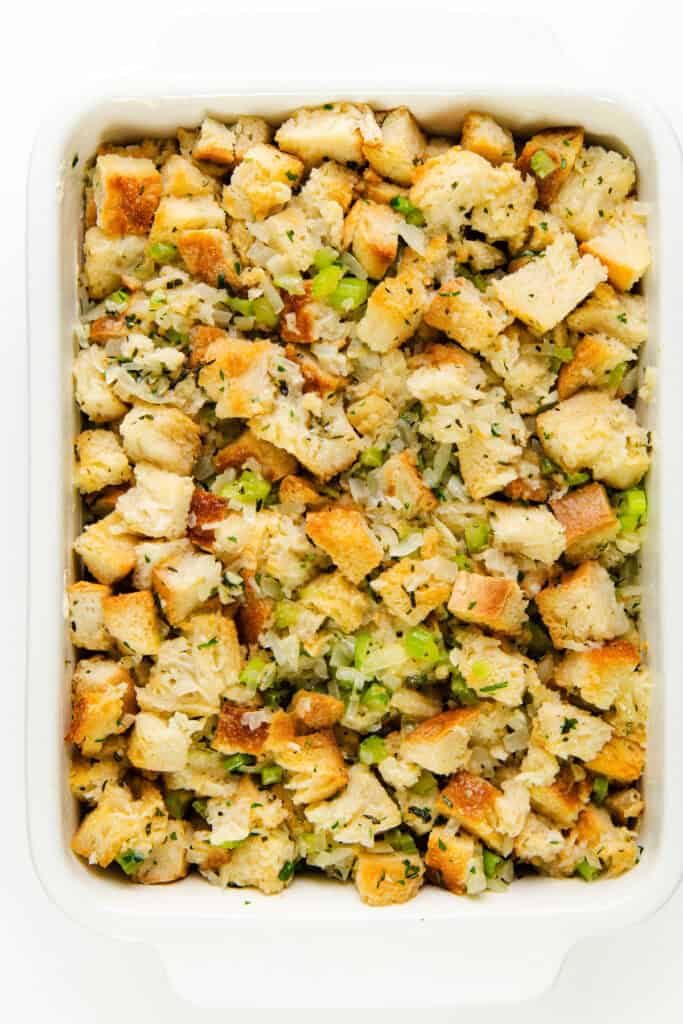
Bake: When ready to bake, preheat the oven to 375°F (190°C). Remove the plastic wrap, keeping the foil on, and bake for 30 minutes. Remove foil and bake for an additional 15-20 minutes, or until the top is golden and crisp.
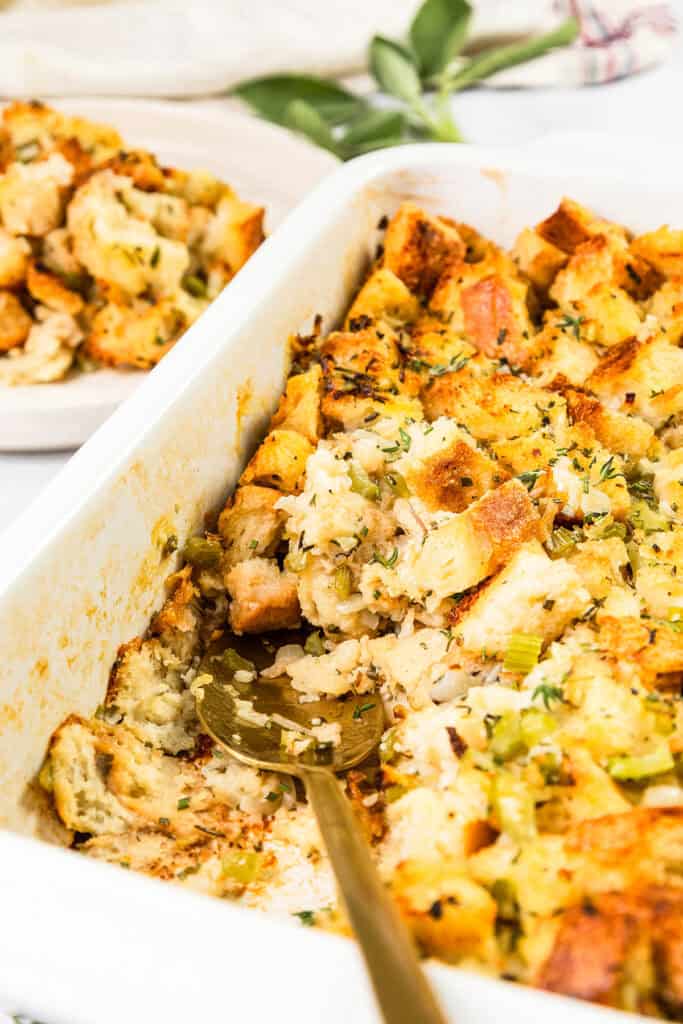
Recipe Shortcuts
- Pre-Chop Vegetables: Buy pre-chopped onions and celery to save time on prep.
- Use Dried Herbs: If fresh herbs are unavailable, use dried. They’re still flavorful and don’t require chopping.
- Toast The Bread Ahead: Toast the bread cubes a day or two early, then store them in an airtight container.
Erren’s Top Tips
- Use stale bread: Fresh bread can turn mushy when soaked in broth. If your bread is too soft, toast it a little longer.
- Taste the broth: Since the bread will absorb most of the flavor from the broth, make sure your broth is well-seasoned before adding it.
- Don’t over-mix: Stir the bread mixture just enough to combine everything. Over-mixing can lead to dense stuffing.
Storage & Freezing Instructions ❄
Storage: Once your herb stuffing is baked, store any leftovers in an airtight container in the fridge for up to 3 days. Reheat in the oven at 350°F until warmed through.
Freezing: You can freeze unbaked stuffing for up to a month. Just wrap it tightly in plastic wrap and foil. Thaw overnight in the fridge before baking.
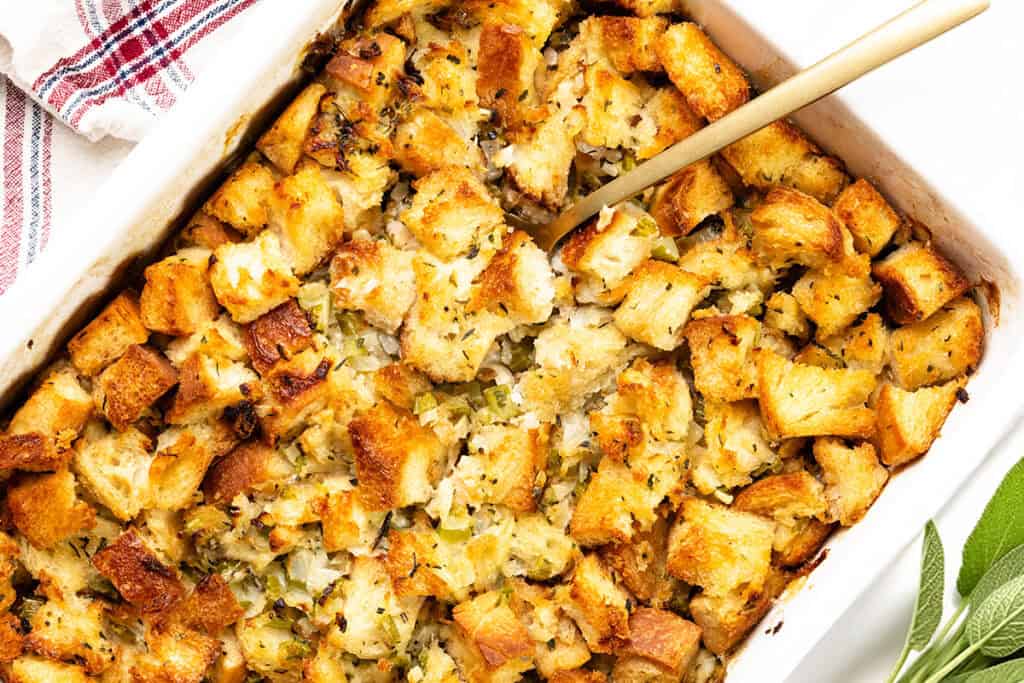
Make It Your Own
You can easily change this herb stuffing recipe to suit your taste! Try adding sausage for a heartier version (or see my sausage stuffing recipe), or mix in mushrooms for extra earthiness. If you love a touch of sweetness, dried cranberries or chopped apples would be a delicious addition. You could even sprinkle in some toasted pecans for a bit of crunch.
Did you make this?

Recipe
Herb Stuffing
Ingredients
- 1½ lbs of rustic bread (cut into 1-inch cubes (about 16 cups or 24oz of stuffing cubs))
- 14 tablespoons unsalted butter
- 2 large onions (finely chopped)
- 6 celery stalks (finely chopped)
- 4 cloves garlic (minced)
- 2 tablespoons fresh thyme (chopped (or 2 teaspoons dried thyme))
- 2 tablespoons fresh sage (chopped (or 2 teaspoon dried sage))
- 2 tablespoons fresh rosemary (chopped (or 2 teaspoons dried rosemary))
- 2 tablespoons fresh parsley (chopped)
- 3 cups chicken stock (or low-sodium chicken or vegetable broth)
- Salt and freshly ground black pepper (to taste)
- 2 large eggs (or for egg-free option, 1 tablespoon ground flaxseed + 3 tablespoons water)
Instructions
- Preheat the oven to 350°F (175°C). Spread bread cubes evenly onto two large baking sheets and toast in the oven for 20-25 minutes, stirring occasionally, until dry and lightly golden. Remove from oven and let cool.
- In a large skillet, melt the butter over medium heat. Add onions and celery, cooking for 8-10 minutes until softened and translucent. Add garlic, thyme, sage, rosemary, and parsley. Sauté for 2-3 minutes until fragrant, then remove from heat.
- In a large mixing bowl, combine the toasted bread cubes and sautéed vegetable mixture. Gradually pour in 2½ cups of the stock, stirring to evenly moisten the bread. If it looks dry, add the rest of the stock as needed. Season with salt and pepper to taste.
- In a small bowl, whisk the eggs and add them to the bread mixture, stirring until well combined. Transfer the stuffing mixture to a greased 9×13-inch baking dish, pressing down gently to level the top.
- Cover the dish tightly with plastic wrap and foil. Refrigerate for up to 2 days.
- When ready to bake, preheat the oven to 375°F (190°C). Remove the plastic wrap, keeping the foil on, and bake for 30 minutes. Remove foil and bake an additional 15-20 minutes, or until the top is golden and crisp. *See the notes section on how to stuff a bird using the stuffing.
Tips
Bread & Stuffing Options
Pre-made Stuffing Cubes: Using fresh bread is not required. You’re welcome to use store-bought for this recipe. A 24oz bag will work as written, but an 18oz bag will require 2½ cups of chicken stock instead of 3 cups. For Cornbread Stuffing, simply substitute equal parts of store bought cornbread cubes or dressing mix. To use fresh cornbread, toast the cornbread cubes until dried, as they tend to be softer than traditional bread and can easily become mushy. If you live outside the US and only have stuffing breadcrumbs available, and you don’t want to cube your bread, you would need about 8 to 10 ounces (225 to 280 grams) of dried stuffing breadcrumbs. This is roughly half the volume of cubed bread because breadcrumbs are denser and will absorb liquid more quickly.*How to Stuff a Turkey with Herb Stuffing
Stuffing a turkey is a great way to add even more flavor to both the stuffing and the turkey itself. Here’s a step-by-step guide on how to safely stuff a turkey with this delicious herb stuffing recipe:- Prepare the Herb Stuffing as Directed: Follow the instructions to prepare the herb stuffing up to the point where it’s ready to bake. Let it cool completely before stuffing the turkey. Make sure the stuffing is moist but not too wet, as dry stuffing can result in a turkey that cooks unevenly.
- Check Turkey Temperature and Cleanliness: Ensure your turkey is thoroughly thawed and patted dry. Remove the giblets and neck from the cavity if they’re included.
- Loosely Stuff the Turkey Cavity: Fill the main cavity of the turkey with the herb stuffing. Be careful not to pack it in too tightly, as stuffing expands as it cooks. Leave some space for air to circulate, which helps the stuffing cook evenly.
- Stuff the Neck Cavity (Optional): For additional stuffing, you can fill the neck cavity as well. Gently pull the skin over the neck cavity opening and secure it by tucking it under or using skewers to hold it in place.
- Truss the Turkey: If you’re stuffing the turkey, trussing (tying the legs together) helps keep the stuffing securely inside and allows for more even cooking.
- Adjust Cooking Time: A stuffed turkey takes longer to cook than an unstuffed one. Plan to add about 20-30 extra minutes of roasting time per pound. The stuffing itself should reach an internal temperature of at least 165°F (74°C) for food safety.
- Check Temperature Frequently: Use a meat thermometer to check the temperature of the stuffing as well as the turkey meat. Insert the thermometer into the center of the stuffing to ensure it has reached a safe temperature.
- Remove Stuffing Before Serving: Once the turkey is fully cooked, carefully remove the stuffing from the cavity before carving. Transfer the stuffing to a serving dish to make it easier for guests to help themselves and to ensure even cooling.
FAQs
Can I make this herb stuffing vegetarian?
Yes! Substitute vegetable broth for the chicken stock for a vegetarian-friendly stuffing.
Can I use store-bought stuffing cubes?
Yes, pre-packaged stuffing cubes work, though you may miss out on the fresh, homemade bread flavor.
Can I prepare the stuffing the day before?
Definitely! This stuffing can be prepared up to 2 days in advance and refrigerated until you’re ready to bake it.
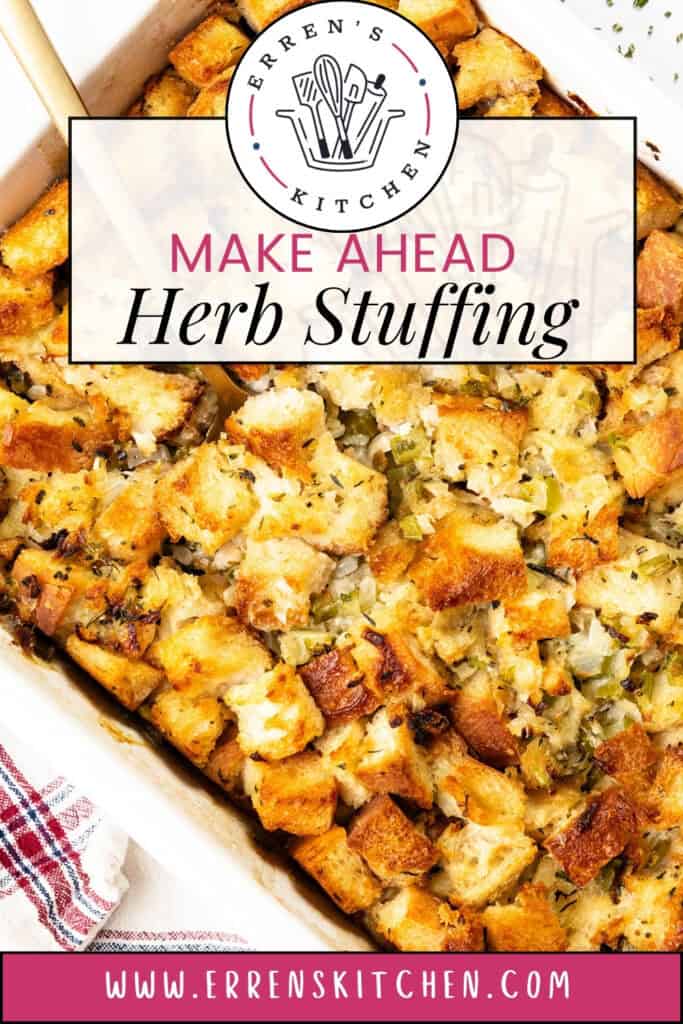
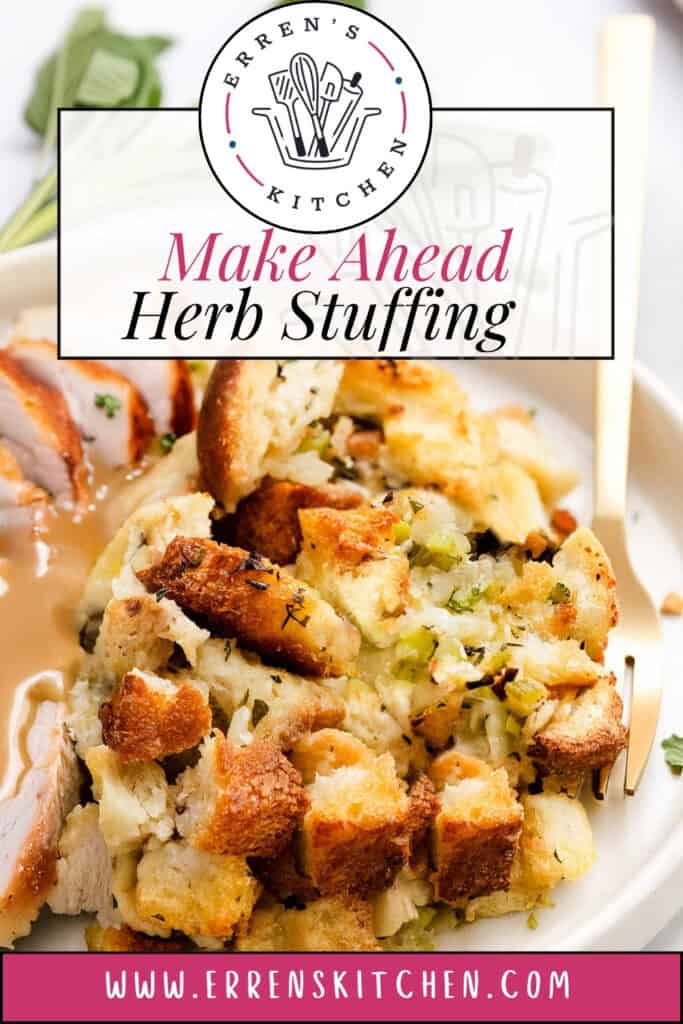
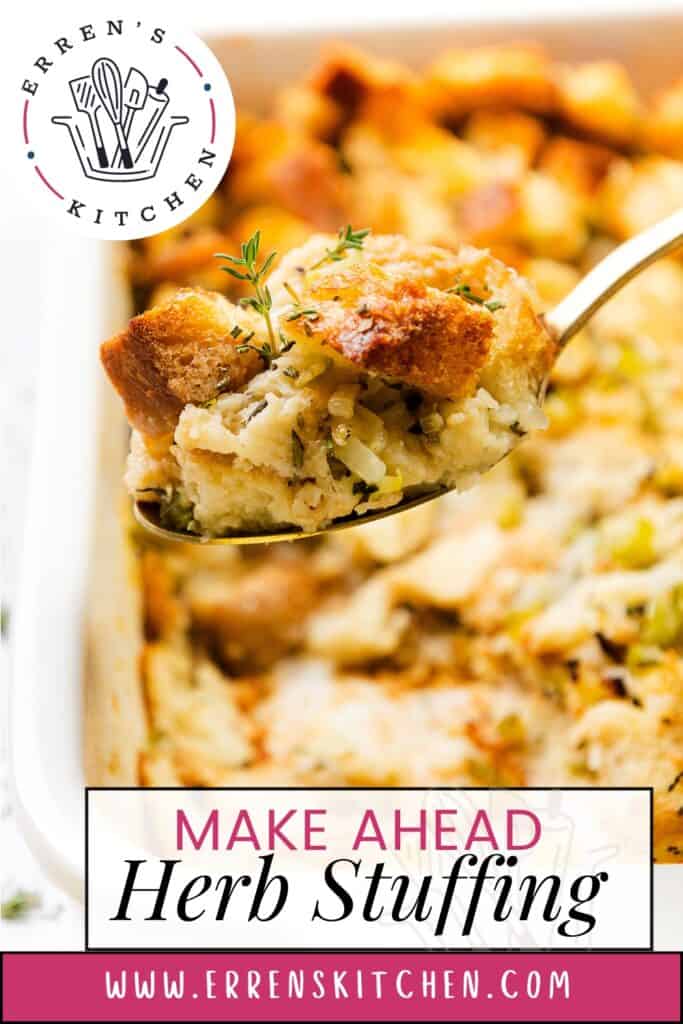

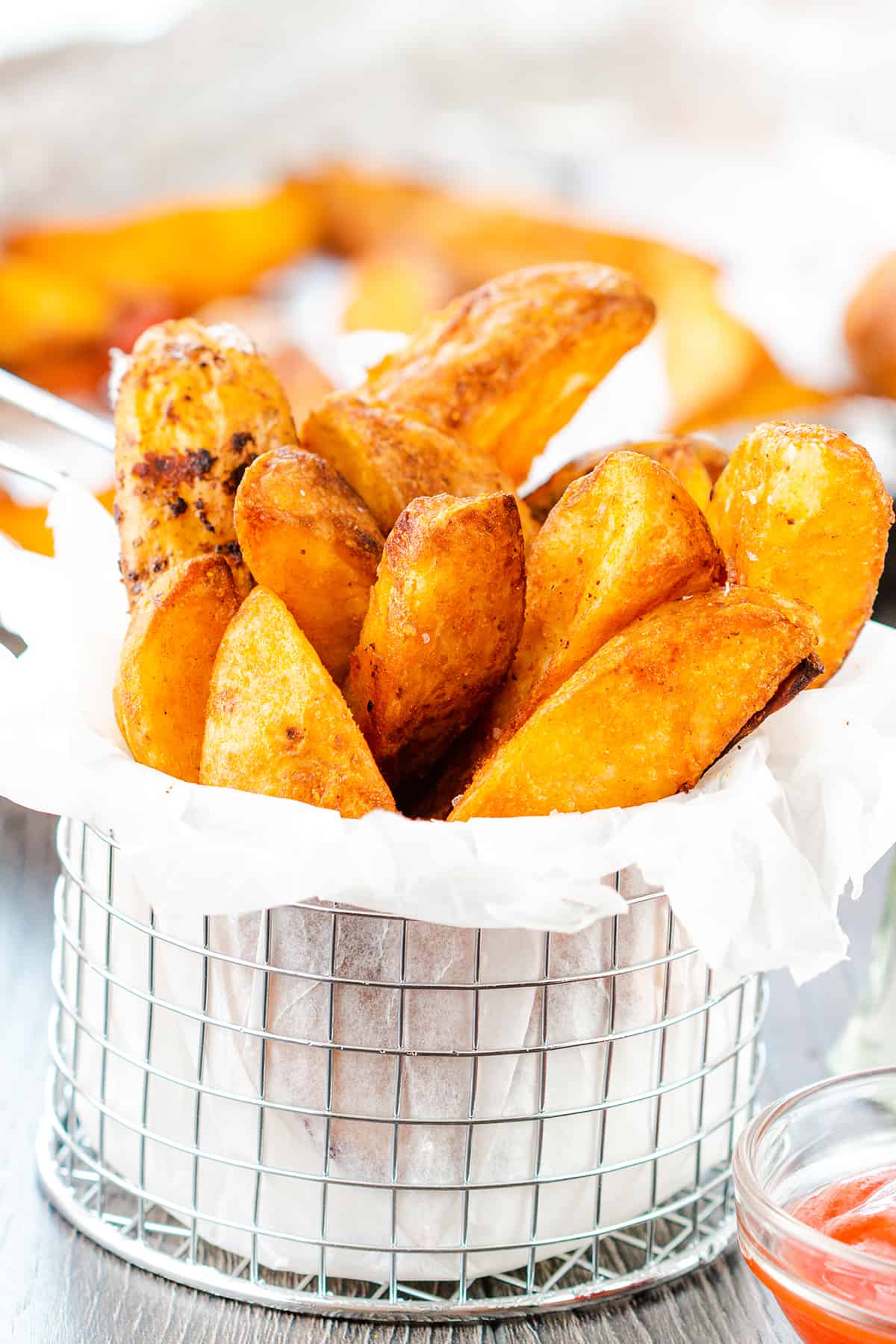
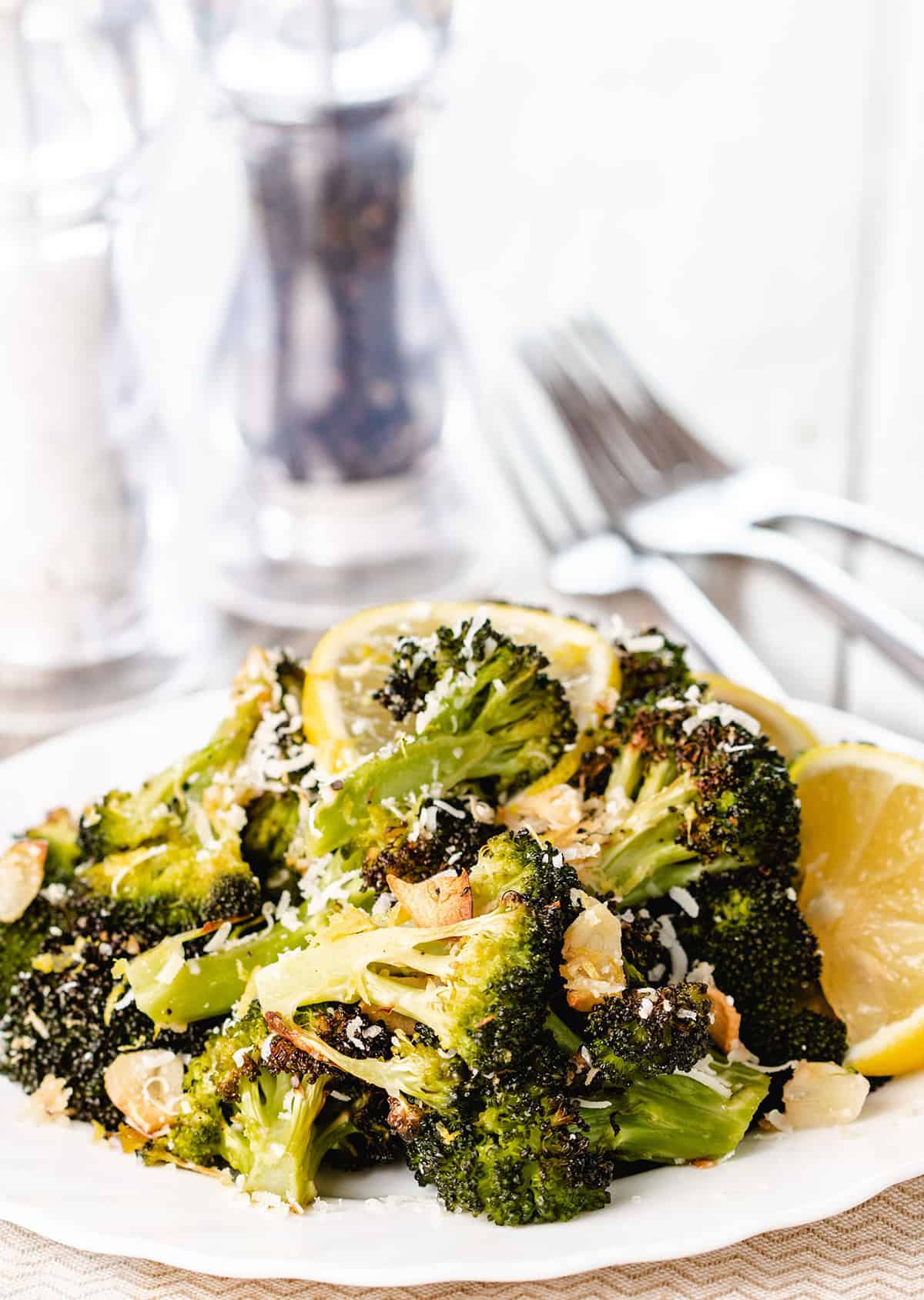
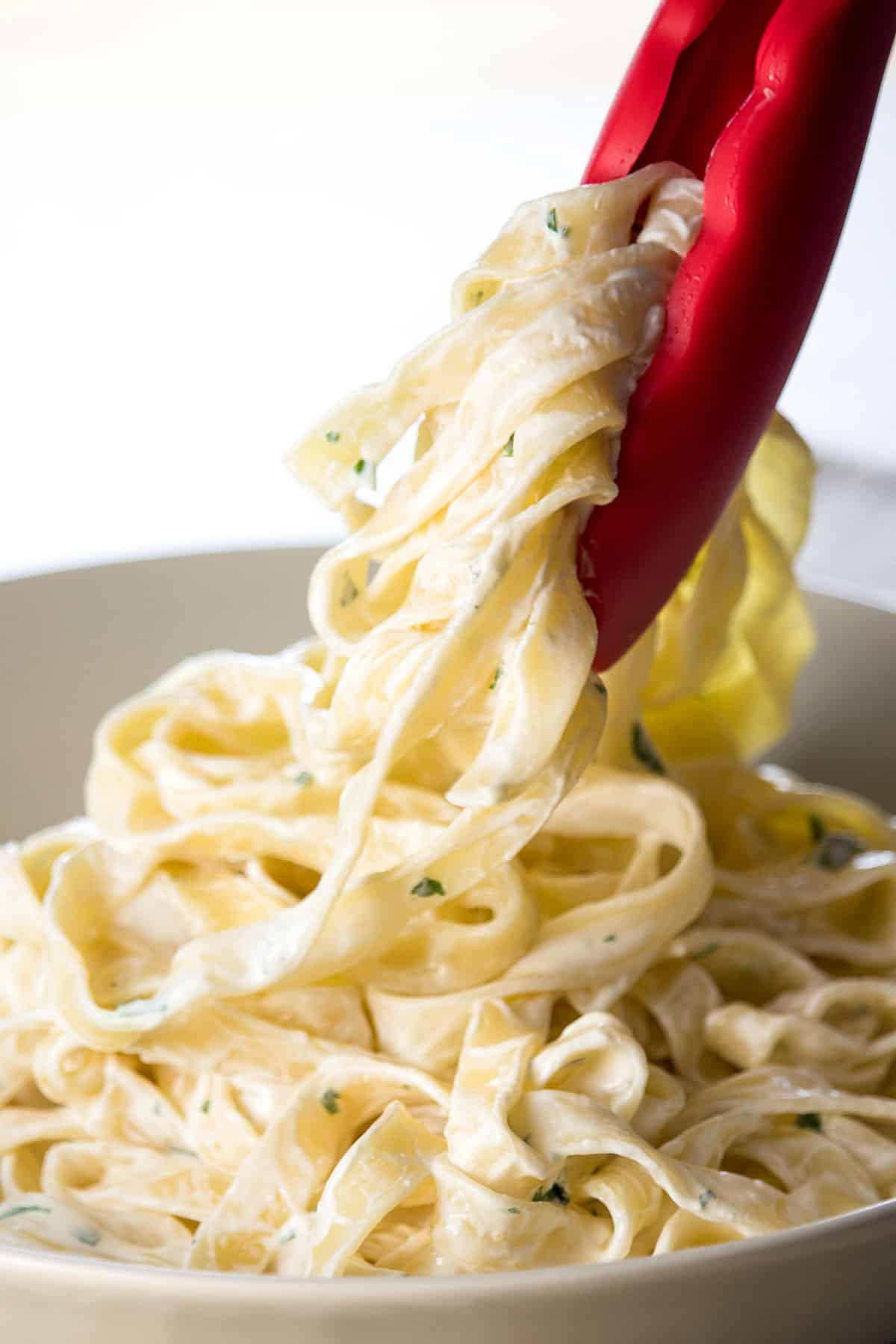
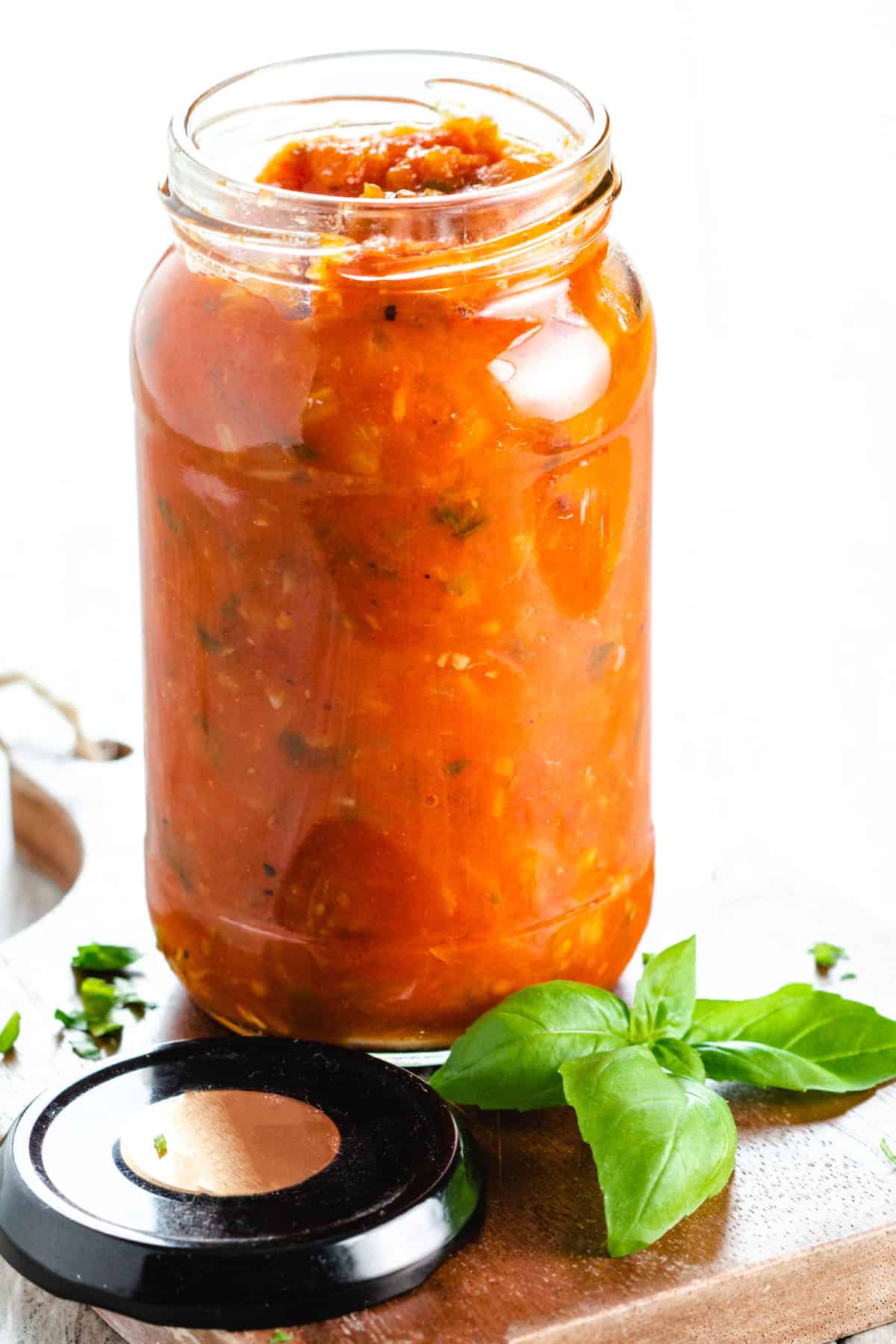
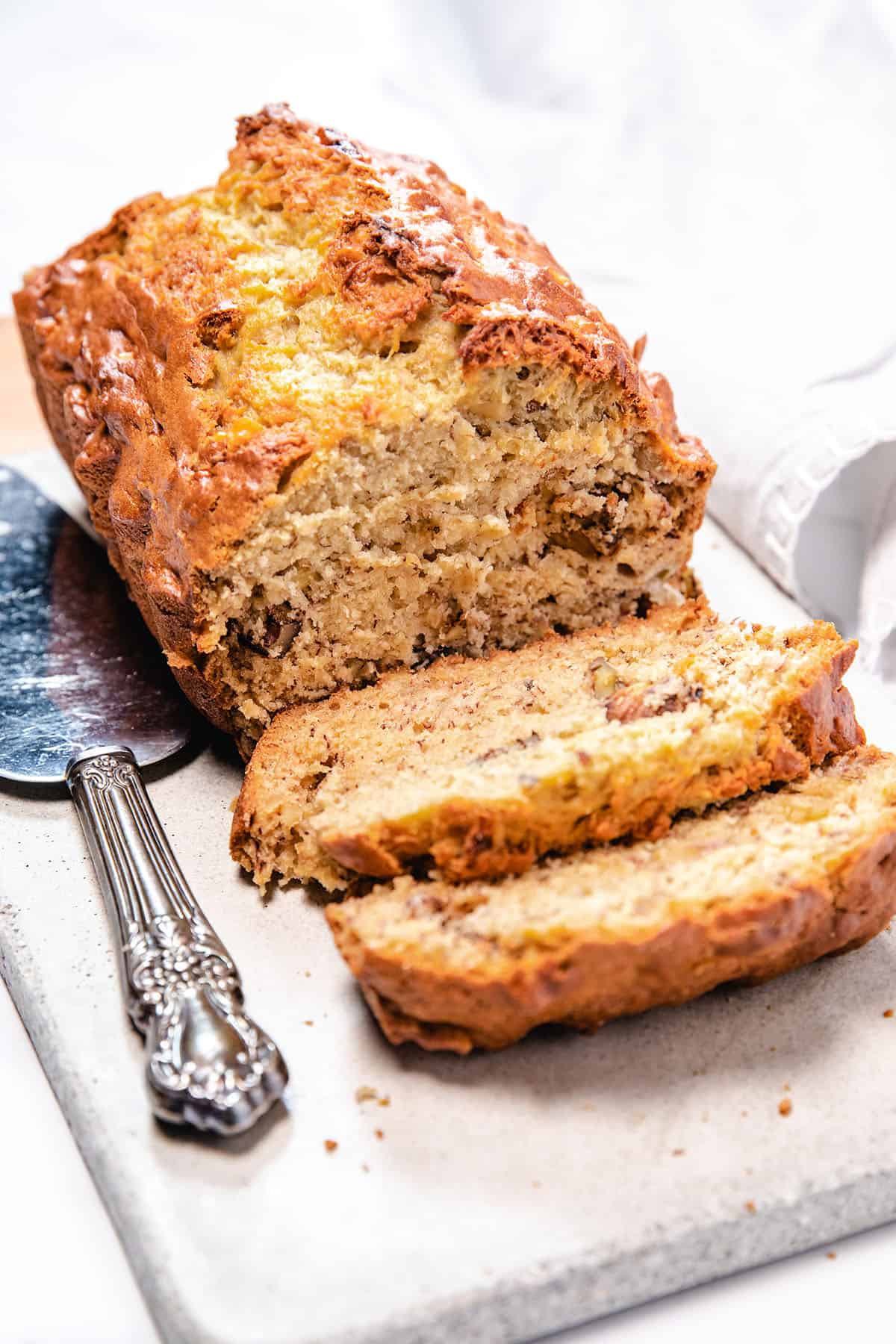
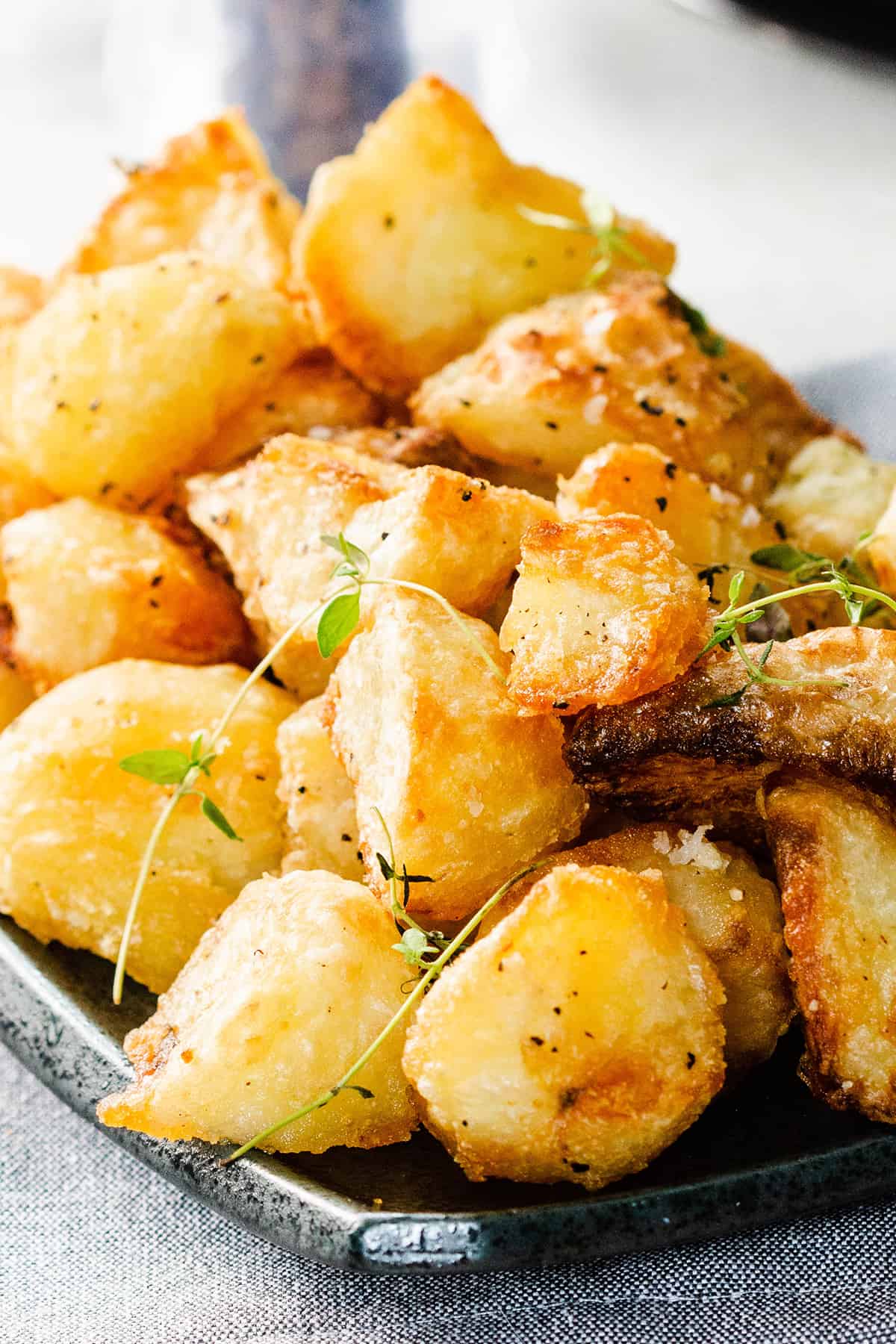

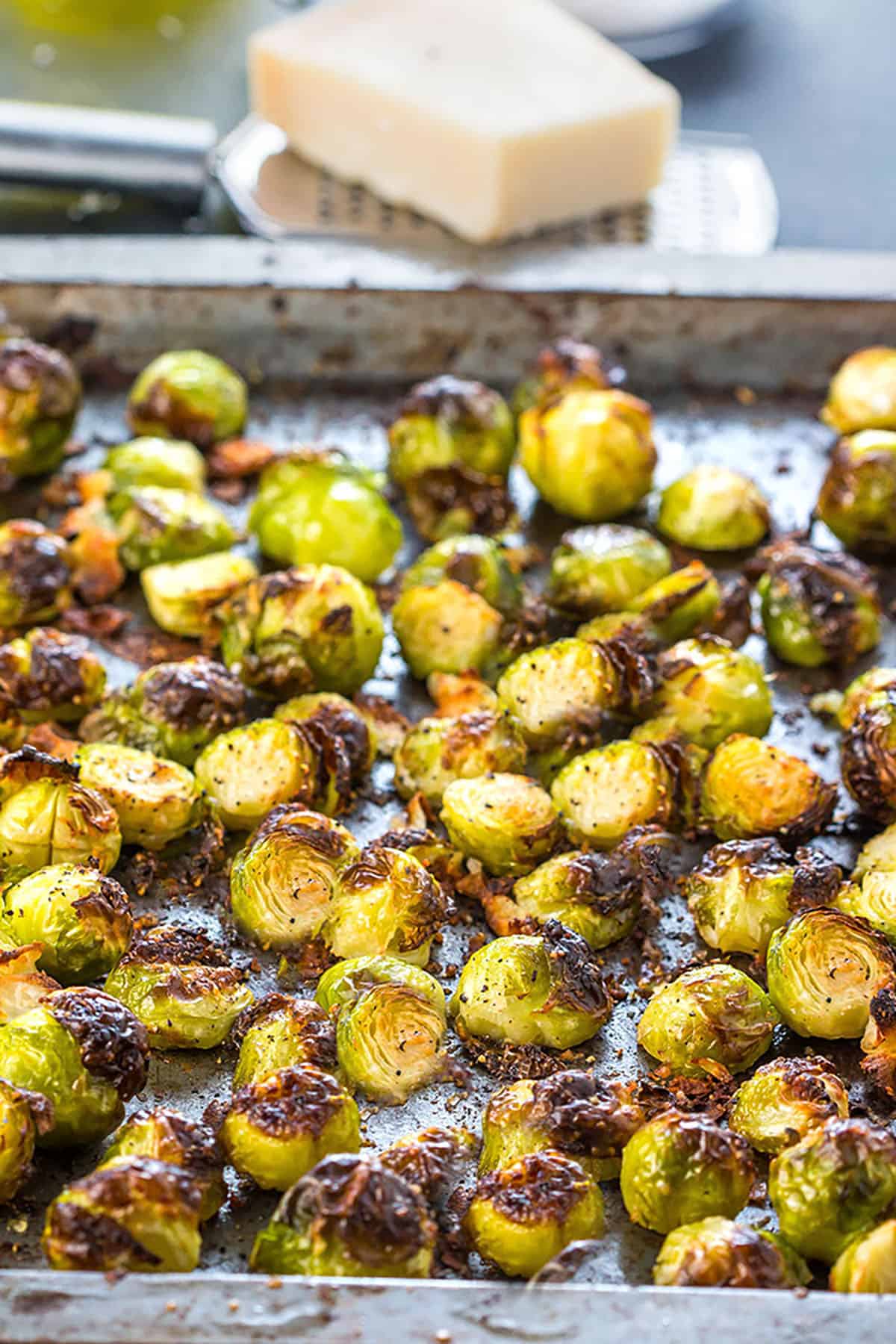
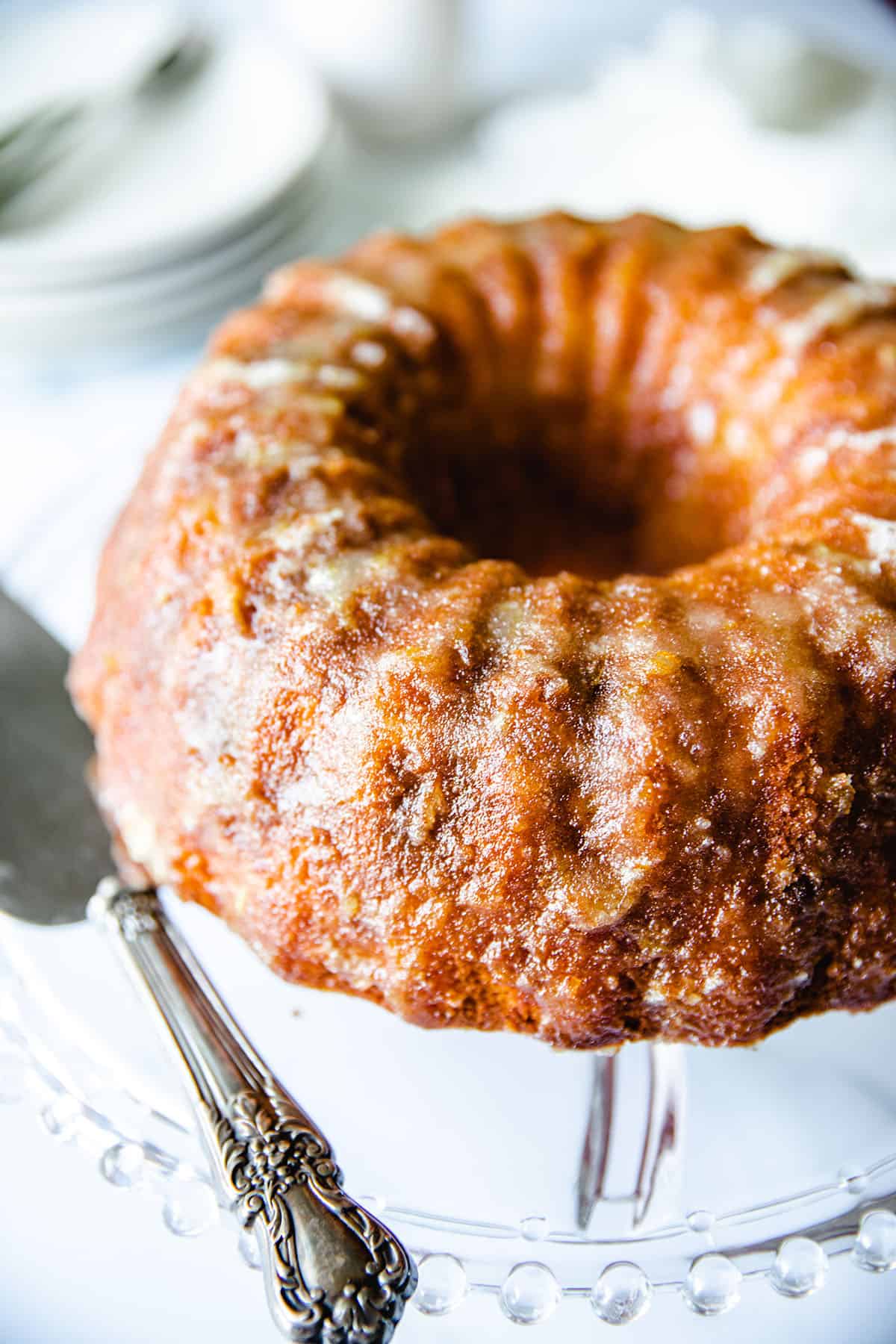
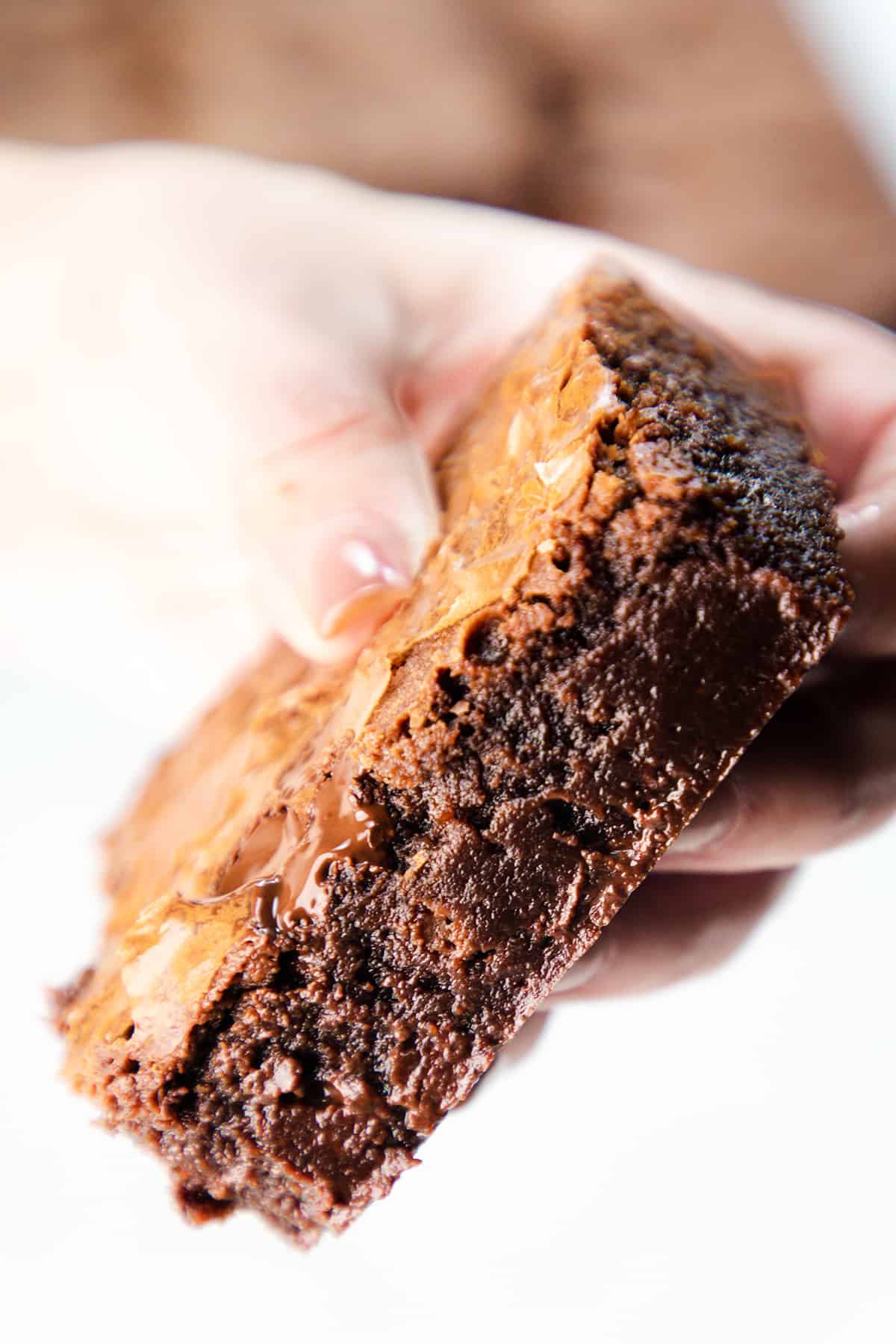

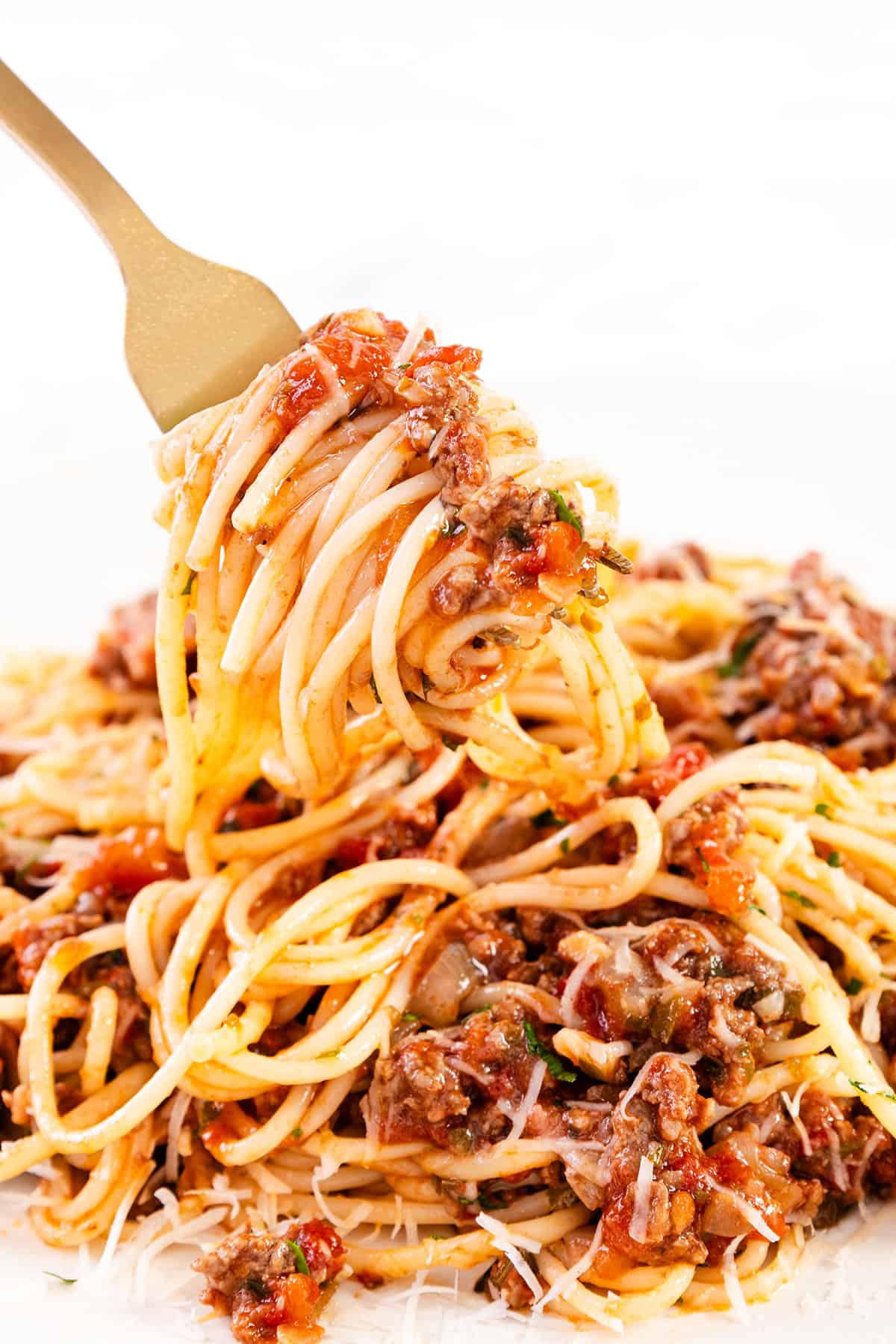
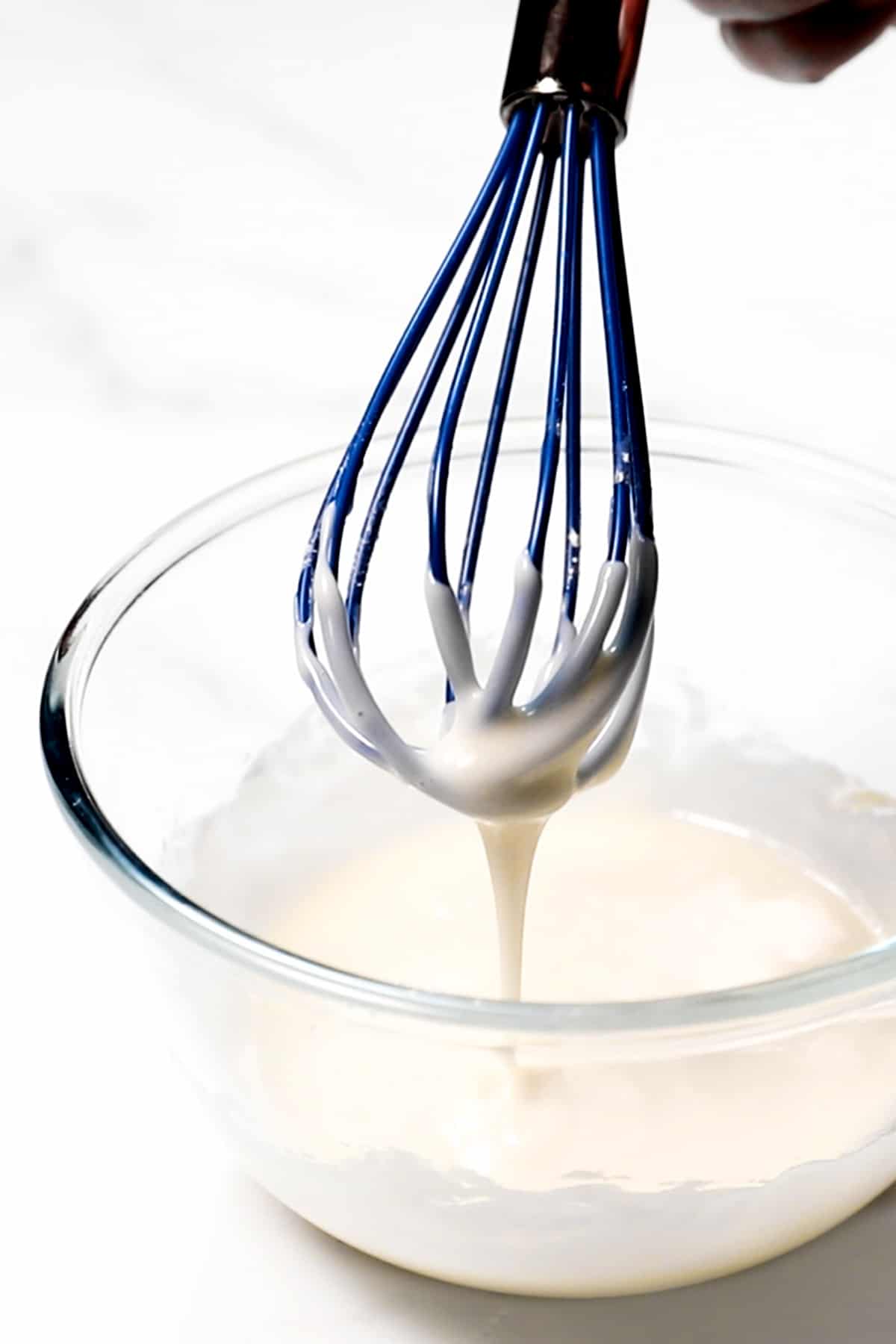

Leave a Reply